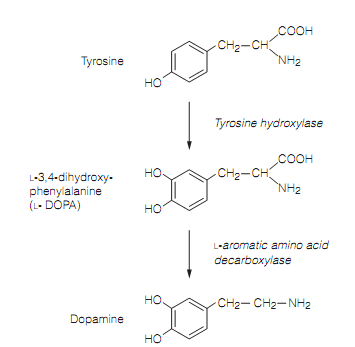Dopamine synthesis
The predecessor for all catecholamine transmitters (like dopamine, noradrenaline (norepinephrine), adrenaline (epinephrine)) is the amino acid, L-tyrosine. And this is hydroxylated by tyrosine hydroxylase to give 3,4-dihydroxy phenylalanine (l-dopa) that is rapidly decarboxylated by the unidentified enzyme l-aromatic amino acid decarboxylase to give dopamine which is as shown in figure below.

Figure: Synthesis of dopamine from the amino acid tyrosine.
Tyrosine is actively transported in the brain, and its concentration of tyrosine is generally enough to saturate the tyrosine hydroxylase (TH), therefore administration of tyrosine cannot modify the rate of dopamine synthesis. Hydroxylation of the tyrosine is a rate-limiting step for catecholamine synthesis under basal conditions and TH is subject to the instruction:
- The Increased expression of TH genes, foremost to de novo synthesis of the enzyme.
- The Phosphorylation by protein kinases that increases its activity.
- The Inhibition by catecholamines. This is an illustration of end point inhibition.
The Dopamine is taken into vesicles by a vesicular monoamine transporter (VMAT) that actively transports catecholamines and serotonin by using the co-transport of protons from the vesicle to give the energy. The VMATs are blocked by the drug reserpine that, by preventing vesicular storage, drastically impairs the monoamine neurotransmission.